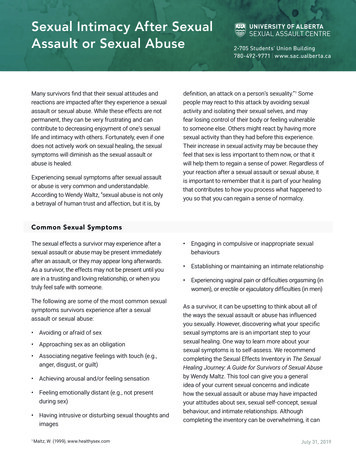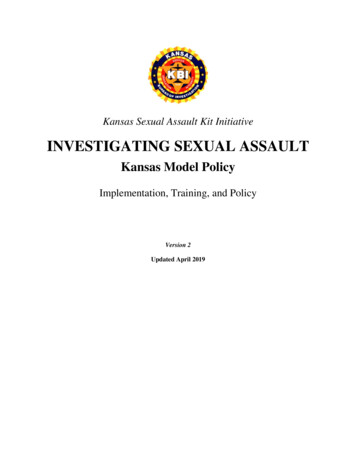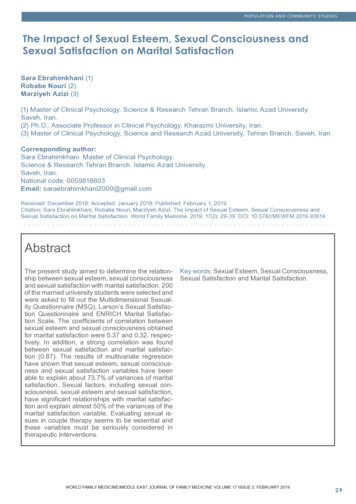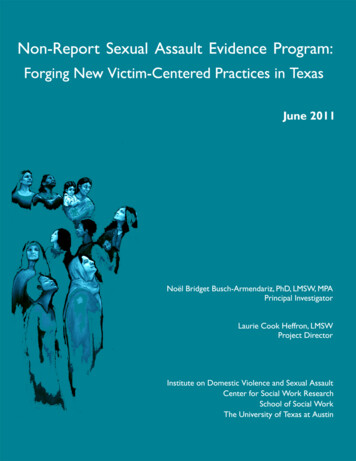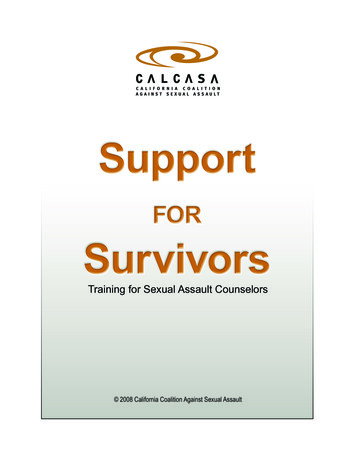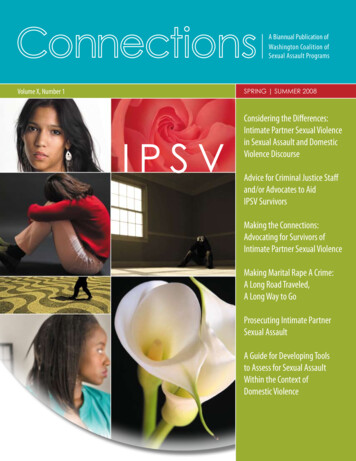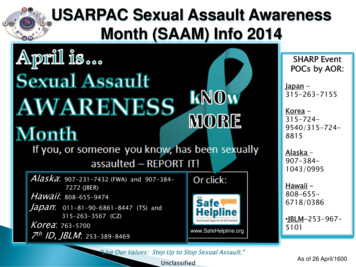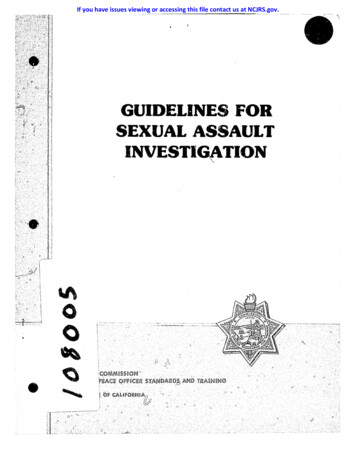
Transcription
If you have issues viewing or accessing this file contact us at NCJRS.gov.GUIDELINES FORSEXUAL ASSAULTINVESTIGATION,"-':: .-,-':',;,,.' u,. ",'-.,i· -"" . - , * ' -.,, , '.""' ."' ,. .,." . ,". ,,, . "., '0,I!.,'",iCOMIIMSSH)N', EA(SQffiCeRS1AWbARo.§; NO T AiNai jGf--.JD0,;::,.'
18005 U.S. Department of JusticeNational Institute of JusticeThis document has been reproduced exactly as received from theperson or organization originating it. Points of view or opinions statedin this document are those of the authors and do not necessarilyrepresent the official position or policies of the National Institute ofJustie,e.Permission to mproduce this copyrighted material has been 1": granted by.COmmlSSlon on PeaceO lcerStandards & Trajnjngto the National Criminal Justice Reference Service (NCJRS).Further reproduction outside of the NCJRS system requires permission of the copyright owner.GUIDELINES FOR SEXUAL ASSAULT INV.ESTIGATION 1II0V 13 1987Prepared by theComm; 55; on on Peace Off; eel' Standards and Tra; n; ng1986
COMMISSIONERSB. Gale Wil sonChairmanCity Managers FairfieldRobert WassermanVice-ChairmanChief of PoliceFremont Police DepartmentSherman BlockSheri ff, Los Angeles CountyGlenn E. DyerSheriff, Alameda CountyCarm J. GrandePolice OfficerSan Jose Police DepartmentCecil HicksDistrict AttorneyOrange CountyEdward MaghakianRetiredRaquel MontenegroProfessor of EducationC.S.U.L.A.Co Alex PantaleoniAssistant Dean, Dept. of PublicServices, Rio Hondo CollegeCharl es B. UsseryChief of PoliceLong Beach Police DepartmentRobert L. VernonAssistant Chief, Los AngelesPolice DepartmentJohn Van de KampAttorney GeneralNorman C. BoehmExecutive Director, Commissionon Peace Officer Standardsand Training
FOREWORDSexual assault is one of the most offensive crimes committed in our society.Not only is it a threat to the community, but may also physically and psychologically affect the victim in many ways. The emotional trauma of beingsexua lly assaulted may differ from vi ctimi zati on in other forms. The personalnature of this act makes it even more critical that responding officerspossess the skills and sensitivity necessary to provide the victim with thesupport he/she needs.Penal Code Section 13S16 mandates that the Commission on Peace OfficerStandards and Training (PGST) prepare guidelines establishing standardprocedures which may be follo\'/ed by law enforcement agencies in theinvestigation of sexual assault cases. This statute also requires POST toprepare and implement a course for the training of specialists in theinvestigation of sexual assault cases. This guideline document has beenrecently updated to incorporate changes in the law and changes ininvestigative procedure. Guidelines are presented in a format that will allow the reader to follow astep-by-step process for conducting a sexual assault investigation. POSTencourages the sharing of this information with all law enforcement personnelwho may serve as the liaison between the sexual assault victim and thecriminal justice system The technical information contained in this document is updated from theoriginal 197/j document "Advanced Sexual Assault Investigation." For specificinformdtion concerning investigating crimes against children, the reader isreferred to the document "POST Guidelines for the Investigation of ChildPhysical Abuse and Neglect, Sexual Abuse and Exploitation."The Commission appreciates the contributions of the Sexual Assault AdvisoryCommittee along with the assistance of Inspector Lawrence Lindenau of theBerkeley Police Department. Special thanks is extended to Sergeant ThomasHood of the Berkeley Police Department who served as project director whileworking for PUST as a Management Fellow Consultant.Questions or comments concerning this document should be directed to theTraining Program Services Bureau at (916) 739-5372. For information onobtaining additional copies of this document, please call the POST Library at(9'16) 73 -5353.NURMAN C. BOEHMExecutive Director
SEXUAL ASSAULT ADVISORY COMMITTEENick Battaglia, DetectiveSan Jose Police Department201 West Mission StreetSan Jose, CA 95110(408) 277-4102Diane L. Huddleston, InvestigatorUCLA Police Department601 Westwood PlazaLos Angeles, CA 90024( 213) 206-Ul36Ralph W. Bennett, DetectiveLos Angeles Police Department150 North Los Angeles StreetLos Angeles, CA 90012(213) 485-2883Michael Jett, Senior Field DeputyCrime Prevention CenterOffice of the Attorney General1515 K StreetSacramento, CA 95814(916) 324-8632Kenneth Mark Burr, Deputy District AttorneyAlameda County DistrictAttorney's OfficeCourthouse, Room 90U1225 Fallon StreetOakland, CA 94612(415) 874-6565Dick Kuest, LCSWCalifornia Office of Child AbusePrevention744 P Street MS 9-100Sacramento, CA 95814(916) 324-2757Lucy Carlton, SergeantMilpitas Police Department455 E. Calaveras BoulevardMilpitas, CA 95035(408) 942-2446Elizabeth Dickinson, SergeantLos Angeles County Sheriff's Department11515 Colima RoadWhittier, CA 90604(213) 946-7974 or( 21 3) 545-8477LeRoy H. Downs, Supervising Probation OfficerSacramento County Probation Department9601 Kiefer BoulevardSacramento, CA 95827(916) 363-3161 Seth L. Goldstein, InspectorSanta Clara County DistrictAttorney's Office7D West Hedding StreetSan Jose, CA 95110(408) 299-7442Elizabeth Lennon, ACSWSan Diego County Social ServicesBureauChild Protective Services6950 LevantSan Diego, CA 92111(619) 560-2121Linda L. Lee, DetectiveFresno County Sheriff's Department2200 Fresno StreetFresno, CA 93717(209) 488-3747Judy A. IIJesse McGuinn, MSWState Department of Social ServicesFoster Care Bureau744 P Street MS 5-400Sacramento, CA 95814(916) 324-2760llJames J. Mead, DirectorFor Kids Sake, Inc.753 W. Lambert StreetBrea, CA 92621(714) 529-8358
Susan 01;viera, PhDCentral Coast Counties Police AcademYGavilan College 055 Santa Teresa BoulevardGilroy, CA 95020(408) 847-150U ext. 283Marilyn Strachan PetersonCalifornia Office of Criminal JusticePlanning1130 K Street, Suite 300Sacramento, CA 95714(916) 324-9120Michael E. Phalen, LieutenantPleasant Hill Police Department330 Civic DrivePleasant Hill, CA 94525(415) 671-4600 R. P. "Toby" Tyler, SergeantSan Bernardino County Sheriff1sDepartmentP.O." Box 569San Bernardino CA 92402(714) 383-3731PROJECT COORDINATORThomas B. Hood, SergeantBerkeley Police Department2171 McKinley AvenueBerkeley, CA 94703Management FellowCommission on POST
TABLE OF CONTENTSINTRODUCTION . . iGENERAL SEXUAL ASSAULT INVESTIGATIVE GUIDELINES . 1INTERVIEW AND INTERROGATION TECHNIQUES8APPENDICESA)PENAL CODE SECTION 13516B)LAWS PERTAINING TO SEXUAL ASSAULT·C)PHYSICAL EVIDENCE COLLECTION/PRESERVATION INFORMATION SHEETD)SEXUAL ASSAULT INVESTIGATIVE CHECKLISTSOURCES CONSULTED
INTRODUCTI ONThe law enforcement officer is one of the most visible authority figures inour society. When the public perceives the need for assistance, the policeofficer is usp.ally the first one to be called. Each officer must be welltrained, well informed, and empathetic to the needs of the community membershe/she serves. This becomes critical when the offense involves sexual assault.Unlike other criminal acts, sexual assault may cause lasting emotional scars.The skill and sensitivity of the officers handl ing the investigation may easethe victim's trauma and give him/her a sense of security and support. Due tothe very personal nature of the offense, the responding officer must attemptto establish a rapport with the sexual assault victim so that complete andaccurate information about the offense can be obtained.Many times little or no physical evidence is found to corroborate the victim'sstatement. Thus, the criminal justice system must rely on the skills of thepolice officers handling the investigation to provide the necessaryinformation to successfully prosecute the offender. Often, it comes down tothe victim's statement of what took place versus the offender's denial. Law enforcement has a legal and moral obligation to thoroughly investigatereports of sexual assault and to determine whether a crime has in fact beencommitted. This investigation should be carried out in a professional andsensitive manner to protect the rights of the alleged victim AND the suspectedoffender. The work done during the initial phases of the investigation mayhave a positive or negative impact on both the victim as well as on thesuccessful prosecution of the offender. Sexual assault investigations maybecome complicated and labor intensive. Officers involved in sexual assaultinvestigations should have specialized training in modern investigativeprocedures including the proper method for interviewing victims, witnesses,and suspects.This guideline document updates the Advanced Sexual Assault InvestigationManual published by POST in 1978. A guideline, by definition, is a statementof policy or procedure. This document presents the information needed toconduct a sexua1 assault investigation in such a way that the reader canfollow a step-by-step process as ino.\ca '.ed on the chart that follows. Theguidelines are general and designed tl. r rovide order and continuity to lawenforcement investigations. Ths sequence of the guidelines follows the normalprogression of events from the receipt of the initial report to the completionof the case summary for the prosecuti ng attorney.Whether or not the offender is apprehended, law enforcement personnel shouldadopt the role of resource provider. The sexual assault victim should beprovided with resource information that will allow him/her to obtain medicaland/or psychiatric counseling. Information should also be provided pertainingto State and local victim/witness assistance programs i
The appendix contains reference material that may assist in ciarifying thesubjects discussed in the guidelines. Law enforcement agencies are encouragedto share the information in this document with all officers who may be calledupon to handle a sexual assault investigation.More detailed investigative information is available in a POST-certifiedSexual Assault Investigation Course . ii
SEXUAL ASSAULT INVEST GATIVE PROCEDURESInitial Report and Evaluation of Infonnation.I. Preliminary Investigative ProceduresFollow-up Investigative Procedures ;
------- --- CHAPTER ONE - GENERAL SEXUAL ASSAULT INVESTIGATIVE PROCEDURESI. INVESTIGATIVE PRIORITIESGuideline #1 - Investigative ObjectiveThe primary objective of the investigation is the protection of the victim andthe safeguarding of the community.Guideline #2 - ResponsibilityLaw enforcement personnel have the responsibility to conduct an objective andunbiased investigation.Guideline #3 - Legal RightsLaw enforcement investigators should protect the rights of ALL involvedparties to include the:a)b)c)victimaccusedwitnessesGuideline #4 - Support for Victim It is critical that both the initial investigating officer and the follow-upinvestigator gain the confidence of the victim. This rapport will assist theinvestigator by fostering an atmosphere of mutual trust and cooperation aswell as providing the victim with the necessary emotional support he/she mayneed.Guideline #5 - Support GroupsIt is impol"tant that law enforcement agencies maintain a liaison withcommunity support organizations that may be able to provide aid to the sexualassault victim and his/her family. Each law enforcement agency shouldmaintain a list of community support groups for the use of its fieldpersonnel. This list should contain the following:a)b)c)d)e) name, address, and phone number of the support organizationname of contact person(s)hours/days of operationspecific services offeredcost (if any)-1-
II. INITIAL RECEIPT AND EVALUATION OF INFORMATION Guideline #6 - Initial ReportIt is the responsibility of law enforcement personnel receiving the initialreport to:a)b)c)d}gather the pertinent facts (who, what, \vhere, when, hO\ /)assess the continued risk to the victim's physical and/or emotional wellbeingdetermine the priority of responseconsider coordination of response with other pertinent agenciesGuideline #7 - Law Enforcement ResponseUpon the initial receipt and evaluation of a reported offense, the urgency ofthe response should be based on the following considerations:a)b}c)d}e)f}need for medical attentiondanger to the victimwhether suspect still has access to the victimpotential for evidencepotential for loss of evidenceacquaintance vs. stranger sexual assaultGuideline #8 - Responding Officer The first officer on the scene should assess the continued risk to the victim'sphysical and/or emotional well being and determine whether a crime has beencommitted by obseY'Ving and by conducting initial interviews with:a}b)c)reporting partyvictimall witnessesIII. PRELIMINARY INVESTIGATIVE PROCEDURESGuideline #9 - Initial InformationIn the preliminary investigation, the following information should be gatheredto substantiate the allegation of sexual assault:a)b)c} type and extent of sexual contactidentification of ALL persons with possible knowledge of the incidenta detailed description of the crime scene (if known)-2-
Guideline #10 - EvidenceAll evidence in support of the allegation of sexual assault should be gatheredand preserved including:a)b)c)d)e)photographs of victim and/or crime scenefindings in a sexual assault medical examinationarticles of clothing from the victim and the suspected offenderbiological body fluidsbedding and/or other materials usedNOTE:A comprehensive medical examination protocol for sexual assault victimshas been developed by the California Office of Crimir.al JusticePlanning. Every effort should be made to assure that the medicalexamination of the sexual assault victim is consistent with protocolgui del i nes.Guideline #11 - Victim Notification of Investigative ProceduresIf appropriate, the victim should be advised of the steps he/she willencounter in the preliminary investigation including:a)b)c)d) in-depth interviews (specific/personal questions)extensive medical examination protocolfollow-up investigation procedures (interviews; identify suspects)judicial process (courtroom testimony/procedures)Guideline #12 - Suspect IdentificationThe officer should seek to identify a suspect and determine whether or not tointerview and/or take a him/her into custody. (See Guidelines 26 and 33)Guideline #13 - Suspect Interview/InterrogationIn sexual assault cases, the investigating officer(s) should determine:a)b)c)d)e)suspect1s awareness of the investigationwhen the suspect should be made aware of the investigationwhen the suspect should be interviewed/interrogatedwho should do the interview/interrogation of the suspectwhere interview/interrogation should take placeGuideline #14 - Special NotificationsNotification of special units may be necessary when the victim is a minor andit appears that a parent, guardian, or caretaker is the alleged offender.Gu"jdeline #15 - DocumentationThe preliminary investigative report should contain the necessarydocumentation including: a)b)c)d)statementsobservations (i.e., victim1s physical/emotional condition, etc.)physical evidence noted and securedactions taken by the investigating officer and others-3-
Guideline #16 - Impact of Investigation Every law enforcement officer should be aware of the fact that the actionstaken during the preliminary investigation coupled with the quality of thepolice report will have a crucial bearing on the welfare of the victim and thesuccessful prosecution of the case.Guideline #17 - Victim-Witness Assistance FundInvestigating officers should provide the victim with information pertainingto the benefits affo.rded crime victims by the State of California VictimWitness Assistance Fund. If necessary, the victim should be referred to alocal support group that provides assistance in the application process.IV. FOLLOW-UPINV STIGATIVEPROCEDURESGuideline #18 - Scope and Direction of the InvestigationThe investigator should review the completeness of the preliminaryinvestigation to determine the scope and direction of the follow-upinvestigation including: a)b)c)d)e)f)g)confirmation of the elements of the crimeneed for further interviewsreview of all evidencedetermination of investigative prioritiesneed for' case confi dent i ali tystatus of the victim (mental and physical)status of the suspect (mental and physical)Guideline #19 - Records ChecksA thorough records check of the suspect should be conducted to include:a) criminal history datab) various computer system checksc) Department of Justice Registrations and Compliance files (290 PC)d) outside agency files and resourcesGuideline #20 - Investigative LeadsInvestigative leads should be explored and developed through the use of thefollowing resources:a)b)c)d)e)f)g) State and local lIall-points bulletinsmodus operandi files (M.D.)arrests sketchesphotographic line-upssuspect profilesphysical line-upsfield interview (F.l.) filesll-4-(APB)
Guideline #21 - Additional Victim InterviewsAdditional interviews with the victim (if necessary) should be considered inan effort to:a)b)c)d)e)obtain additional information v/hich the victim vias reluctant or forgot toprovide during the preliminary investigationclarify any inconsistencies in the original reportcheck for bruises or injuries which were not initially visible or notphotographed - take photosattempt to locate additional evidenceprovide information on support groupsGuideline #22 - CorroborationCorroborating information should be developed through:a)b)c)d)e)f)g) medical examination informationwitness statementsphysical evidenceincriminating statements made by suspectwhether access to the victim by suspect was possible and that he/she hadthe opportunity to commit the offenseM.O. factorsuse of a search warrant, if appropriateGuideline #23 - Additional Sources of Corroborating InformationCorroborating information sources that will assist the investigating officeri ncl ude:a)b)c)d)e)descriptions of crime scene, residence, and/or vehicledescription of marks, scars, and tatoos (especially on those body partsnormally covered by clothing) on suspectitems left behind by the victim and/or suspect at the crime scenepersons the victim may have told prior to the official report toauthorities (best friend, neighbor, clergy, etc.)listening to tape of initial phone call to police by victim (if available)Guideline #24 - Background InvestigationA thorough background investigation should be conducted on the suspectincl uding:a)b}c)previous residences (prior offenses in another jurisdiction)previous relationships (spouse, ex-spouse, live-in, relatives)contacts with other agencies and/or jurisdictionsGuideline #25 - EvidenceAll evi dence gathered throughout the i nvesti gati on shoul d be coll ected,analyzed, and evaluated -5-
Guideline #26 - Suspect Interview/InterrogationThe suspect should be interviewed/interrogated using the following criteria asa guide:a)b)c)d)advise suspect of his/her constitutional rights and nature of theinvestigation when appropriateconsider, evaluate, and investigate all new information and alternativeexplanations provided by suspectcorroborate information already obtained through investigationobtain incriminating statements including admissions and confessionsGuideline #27 - Arrest of SuspectThe following factors should be considered \'lhen determining whether or not toarrest the suspect:a)b)c)d)e)f)nature of the offense (felony/misdemeanor)imminent danger to the victim, community, or selflikelihood the suspect will fleedestruction of evidencepotential ramifications of the arrestimpact on the case developmentGuideline #28 - Case Review The final review and case summary should include the:a)b)c)d)e)f)g)h)disposition of the victimevidence identified and collectedstatementsdisposition of the suspectcoordination and consultation with other involved agenciesneed for confidentiality of case informationreport of the case progress to appropriate parties to the offensecompletion of all mandated report requirement formsGui del i ne #29 - Case SummaryIn complicated cases or where there are multiple victims, incidents oroffenders, a case summary might help to emphasize the important points theinvestigator wishes to make. The summary may include:a)b)c)d) a synopsis of pertinent points of the investigationcharts showing relationshlps of the parties involved in the offensecharts depicting the type and number of offenses involved and how theyrelate to the prosecution of the offender(s)diagrams of the crime scene for courtroom presentation-6-
Guideline #30 - Preparation of the Witness for CourtIn some jurisdictions the law enforcement investigator may be responsible forpreparing the victim for courtroom testimony. In an effort to ease thedi scomfort of the vi ctim whil e testifyi ng in court, the foll O'l/i ng techn; quesshould be considered:a)b)c)d)invite the victim and support persons to come to the prosecutingattorney's office prior to the hearing or trialexplain lat the victim will be required to do while in courtallow the victim to visit the empty courtroom and (if appropriate)encourage him/her to sit in the witness chairremind young victims to "just tell the truth"Guideline #31 - Continued Contact with VictimThe law enforcement investigator should maintain contact with the victim untilthe conclusion of the judicial process. The victim should be providedperiodic status reports on the progress of the investigation orprosecution status of the offender. -7-
------------------- ---------- ------------CHAPTER TWO - INTERVIEW AND INTERROGAT10N TECHNIQUESI. GENERAL CONSIDERATIONSGuideline #32 - Objective of InterviewThe objective of the interview is to determine the truth of the allegation(s)of sexual assault without further traumatizing the victim.Guideline #33 - Law Enforcement ResponsibilityThe primary responsibility for conducting criminal investigative interviewsand interrogations rests with law enforcement.Guideline #34 - Interview and Interrogation ConsiderationsWhen conducting interviews and intel'rogations, the investigating officershould consider the following procedures:a)b)c)d)e) f)g)h)i)j)k)plan and prepare for the interview/interrogation carefullyconsider the use of audio/video technologydetermine the functional level of the victim, witness, and suspectdetermine the various relationships of all parties involved in the allegedoffensedetermine if there are additional victims, witnesses, and suspectsestablish the existence of evidenceprotect confidentiality of all parties involved in the offenseconduct all interviews/interrogations separatelyavoid disclosure of case information to all parties involved in the allegedoffense to prevent contaminationinstruct all parties involved in the alleged offense to maintainconfi denti ali typossibility of parties involved in the offense to recant his/her accountof the incident due to intimidation, guilt, or repercussionII. VICTIM INTERVIEWSGuideline #35 - Minimizing the Number of Victim InterviewsEvery effort shoul d be made to mi nimi ze the number of i ntervi ews with thevictim. Some techniques to consider include:a)b)c)d)e)f) consultation with a specialized law enforcement sexual assaultinvestigative unit (if available) prior to the interviewconducting thorough and well documented interviewscoordination of the investigation with other agencies, if appropriate,use of audio and/or video recordingsconsultations with the prosecuting attorneyseeking out sources of information other than the victim-8-
Guideline #36 - SensitivityCare should be taken to be sensitive to the needs of the victim.to consider ng rapport with the victimcareful selection of interview settingproviding the victim with emotional supporthaving support persons available, if neededuse of interview aids (sketch artist, identikit, etc.)establishing the victim's developmental levelbeing aware that the victim may be blaming himself/herself for the offenserecognizing when to discontinue the interviewbeing aware of cultural differencesinforming the victim of what to expect during the investigationconcluding the interview in such a fashion that the victim feels free torecontact the investigatorGuideline #37 - Special ConsiderationsWhen conducting victim interviews, the investigator should consider thefoll owi ng: a)b)c)d)e)avoid influencing the victim's account of the alleged offenseallow the victim to describe the incident in his/her own wordsestablish time frame(s) and jurisdiction(s) for all alleged offensesavoid technical terminology, if appropriateavoid making false reassurances or promisesIII. WITNESS INTERVIEWSGuideline #38 - Interview ConsiderationsWhen conducting interviews with witnesses to an alleged sexual assaultoffense, the investigating officer should consider the following:a)b)c)d)e)f)g) determine sequence for the witness interviewsdetermine source of the witness's knowledge of the alleged offensedetermine witness's relationship to the victimconsider developmental level of the witnessdetermine the relationship of the witness to the suspectconsider the motivation of the witnessavoid influencing the witness's account of the alleged offense-9-
IV. SUSPECT INTERVIEWS/INTERROGATIONSGuideline #39 - Interview/Interrogation considerationsWhen conducting an interview/interrogation with the suspected offender, thefollowing factors should be taken into consideration by the investigatingofficer:a}b)c)d)e)f)g)h)attempt to gain rapport with the suspectcareful selection of the setting for the interview/interrogationdetermine relationship between the suspect, witness, and victimdetermine if the suspect had access to victim (particularly when allegedoffense took place)note the demeanor of the suspect at the time of the interviewencourage suspect to relate the incident in his/her own wordsnote statements made that are consistent with other findings and evidencenote statements made that are inconsistent with other findings and evidence(for future impeachment purposes)Guideline #40 - Corroboration of Suspect's StatementEvery attempt should be made to corroborate statements made by the suspect.Use of the following information may help the investigating officer accomplishthi s task: a)b)c)d)e)statements by victimstatements by witness(es)physical evidenceprior criminal history dataprio!" complaints by victim(s), witness(es)-10-
APPENDIX
APPENDIX A Commission on Peace Officer Standards and Training - - - - - - - - - - -Sex Crime Investigationp .C. 13516(a)The commission shall prepare guidelines establishing standard procedureswhich may be followed by police agencies in the investigation of sexual assaultcases, and cases involving the sexual exploitation and sexual abuse of childrenincluding police response to, and treatment of, victims of these crimes.(b)The course of training leading to the basic certificate issued by thecommission shall, on and after July 1, 1977, include adequate instruction inthe procedures described in subdivision (a).No reimbursement shall be madeto local agencies based on attendance on or after that date at any such coursewhich does not comply with the requirements of this subdivision. (c)The commission shall prepare and implement a course of training ofspecialists in the investigation of sexual assault cases, child sexual exploitation cases, and child sexual abuse cases.Officers assigned to investigation duties, which include the handling of cases involving the sexualexploitation or sexual abuse of children, shall successfully complete thattraining within six months of the date the assignment was made .(d)It is the intent of the Legislature in the enactment of thi s secti on toencourage the establishment of sex crime investigation units in police agenoiesthro ughout the state, whi ch uni ts shall i ncl ude, but not be limi ted to,i nvesti gating crime s involving the se xual e xploi tation and sexual abuse ofchildren . Revised:1-1-86
APPENDIX B LAWS PERTAINING TO SEXUAL ASSAULTCalifornia Penal CodePC 220Assault with the Intent to Commit RapePC 243.4Sexual BatteryPC 261Rape.PC 261. [,Unlawful Sexual IntercoursePC 262Spousal RapePC 263Sufficiency of PenetrationPC 264Punishment for Rape and Unlawful Sexual IntercoursePC 2b4.lAiding or Abetting RapePC 266cConsent by False or Fraudulent PretensePC 286SodomyPC 287Sodon PC 28HaOral CopulationPC 289Penetration by a Foreign ObjectPC 290Registration of Sex OffendersPC 290.2Specimens of Sex OffendersPC 291/291.1School Employees/Teachers - Arrest for Sex Offenses Notice to School AuthoritiesPC 667.6Enhancement for Prior Conviction or Prior TermPC 667.7Habitual OffenderPC 667.8Kidnapping for Purpose of Committing Sexual Offense,Enhancement Upon ConvictionPC 1203.06Ineligibility for Probation After Committing Violent CrimesPC 1203.065Ineligibility for Probation After Certain Sex CrimesPC 12022Enhancement (2 and 3 years) for Violation of Certain Sex Crimes- Sufficiency of Penetration-1-
A number of provisions of the law require reporting of injuries by crimina')acts to law enforcement agencies by doctors or hospitals.PC 11160Injuries Inflicted by Weapons or Violation of Penal Law(requires hospitals to report).PC 11161Injuries Inflicted by Weapons or Violation of Penal Law(requires physicians and surgeons to report)PC 11166Sexual Assault Committed on Minors - outlines who must reportthese offenses.Health and Safety CodeH&S 1493COlmty Hosp; ta 1 Physicians Conducti ng Exami nati on forEvidence of Sexual Assault -2-f edica 1
PHYSICAL EVIDENCE FOR SUBMISSION TO CRIME LAB RAPE INVESTIGATIONSI. FROM THE VICTIMITErvI1.Vaginal swaband slidesmearHOW TO COLLECTCollected by doctor ornurse from inner vaginalarea.Using the swab - smearsurface of a glass "slide,usually done by doctor ornurse.HOW TO PACKAGEPlace in paper or glasscontainerPRECAUT 1014Ai r dryDo not touch swabPlace in slide maileror small glass bottle. REASO
officer is usp.ally the first one to be called. Each officer must be well trained, well informed, and empathetic to the needs of the community members he/she serves. This becomes critical when the offense involves sexual assault. Unlike other criminal acts, sexual assault may cause lasting emotional scars.
